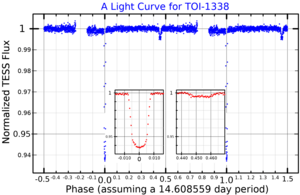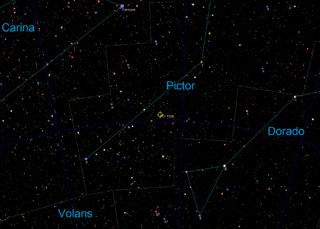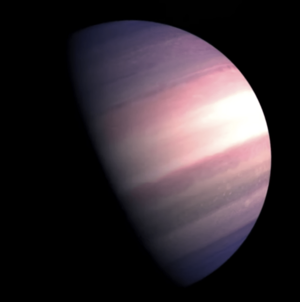TOI-1338 facts for kids
| Observation data Epoch J2000 Equinox J2000 |
|
|---|---|
| Constellation | Pictor |
| Right ascension | 06h 08m 31.968s |
| Declination | -59° 32′ 28.08″ |
| Apparent magnitude (V) | 11.72 |
| Characteristics | |
| Spectral type | F8 / M |
| Variable type | eclipsing |
| Astrometry | |
| Radial velocity (Rv) | 23.56±5.34 km/s |
| Proper motion (μ) | RA: −12.057 mas/yr Dec.: +34.513 mas/yr |
| Parallax (π) | 2.4752 ± 0.0099 mas |
| Distance | 1,318 ± 5 ly (404 ± 2 pc) |
| Orbit | |
| Period (P) | 14.608559+0.00013 −0.00012 d |
| Semi-major axis (a) | 0.1321+0.0024 −0.0025 AU |
| Eccentricity (e) | 0.15603±0.00015 |
| Inclination (i) | 89.696+0.178 −0.114° |
| Semi-amplitude (K1) (primary) |
21.619±0.007 km/s |
| Details | |
| TOI-1338 A | |
| Mass | 1.127+0.068 −0.069 M☉ |
| Radius | 1.331+0.024 −0.026 R☉ |
| Luminosity | 2.1 L☉ |
| Surface gravity (log g) | 4.0 cgs |
| Temperature | 6,160 K |
| Metallicity [Fe/H] | +0.01 dex |
| Rotation | 19±3 d |
| Rotational velocity (v sin i) | 3.6 km/s |
| Age | 4.4 Gyr |
| TOI-1338 B | |
| Mass | 0.3128+0.0113 −0.0118 M☉ |
| Radius | 0.3089+0.0056 −0.0060 R☉ |
| Other designations | |
|
TYC 8533-950-1, EBLM J0608-59, 2MASS J06083197-5932280, RAVE J060832.0-593228
|
|
| Database references | |
| SIMBAD | data |
| Extrasolar Planets Encyclopaedia |
data |
TOI-1338 is a binary star system located in the constellation Pictor, about 1,320 light-years from Earth. It is orbited by two known circumbinary planets, TOI-1338 b, discovered by the Transiting Exoplanet Survey Satellite (TESS) and BEBOP-1c, discovered by the Binaries Escorted By Orbiting Planets project.
Discovery and nomenclature
The circumbinary planet TOI-1338 b was found in the summer of 2019 by Wolf Cukier, a 17-year-old attending Scarsdale High School in New York at the time, who joined the Goddard Space Flight Center as a summer intern. The acronym TOI stands for "TESS Objects of Interest." Cukier studied data provided by volunteers of the Planet Hunters citizen science project, looking through data that had been flagged as an eclipsing binary. Cukier and six of the Planet Hunter volunteers are co-authors of the publication regarding the planet. Cukier currently attends Princeton University as an undergraduate student in the Department of Astrophysical Sciences and is expected to graduate in 2024.
The discovery of TOI-1338 b was announced in early January 2020 at the 235th American Astronomical Society meeting in Honolulu, Hawaii. In February 2021, a petition was launched calling for TOI-1338 b to be renamed SOPHIE in honor of late Scottish musician Sophie. The petition was supported by Charli XCX and Caroline Polachek. The petition was unsuccessful in renaming TOI-1338 b, however, the International Astronomical Union announced that the minor planet 1980 RE1 was given the permanent name Sophiexeon in June 2021.
In June 2023, a second circumbinary planet within the system was announced to have been discovered, named BEBOP-1c. It was the first circumbinary planet to be found using the radial velocity method.
The stellar binary

TOI-1338 is a single-lined spectroscopic binary system, consisting of an F8 star and a red dwarf of spectral type M. The system has an age of 4.4 billion years. The two stars with masses of 1.13 and 0.313 M☉ revolve around each other every 14.6 days. The red dwarf is about nine magnitudes fainter than the primary star and cannot be detected in the spectrum.
The orbit of the two stars is inclined at 89.7° and both primary and secondary eclipses can be observed, although the brightness changes are very small. The primary eclipse occurs when the hotter primary star is partially occulted by the cooler secondary. It lasts about five hours and the brightness decreases by about 4%. The secondary eclipses occur when the cooler star is occulted by the hotter star. They also last about five hours but the brightness drops by less than half a percent.
Planetary system
The planet TOI-1338 b is between Neptune and Saturn in size, and has an orbit that is within ~1° coplanar with the binary. It is roughly 22 times the mass of Earth. The spin of the primary star also aligns with the orbits of the binary and the planet (spin-orbit angle β = 2.8±17.1 °). This is the second time the Rossiter–McLaughlin effect was measured for a star hosting a circumbinary planet. Kepler-16 was the first system with such a measurement. The measurement of the alignment for TOI-1338 suggests that the planet formed from a single circumbinary disk.
BEBOP-1c is a gas giant about 65 times the mass of Earth.
| Companion (in order from star) |
Mass | Semimajor axis (AU) |
Orbital period (days) |
Eccentricity | Inclination | Radius |
|---|---|---|---|---|---|---|
| b | 33.0±20.0 M🜨 | 0.4607+0.0084 −0.0088 |
95.174+0.031 −0.035 |
0.0880+0.0043 −0.0033 |
89.37+0.35 −0.26° |
6.85±0.19 R🜨 |
| c | 65.2+11.8−{{{2}}} M🜨 | 0.794+0.016−{{{2}}} | 215.5+3.3−{{{2}}} | <0.16 | — | — |
See also
- TOI-700
- TOI-849 b



